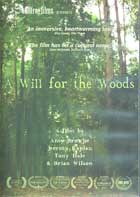
A Will for the Woods 2014
Distributed by Bullfrog Films, PO Box 149, Oley, PA 19547; 800-543-FROG (3764)
Produced by Amy Browne
Directed by Amy Browne, Jeremy Kaplan, Tony Hale, and Brian Wilson
DVD , color, 94 min.
College - General Adult
Death, Ecology, Environmental Ethics
Date Entered: 06/03/2015
Reviewed by Wendy Highby, University of Northern ColoradoA Will for the Woods documents the environmentally innovative legacy left by Clark Wang. The film begins seven years after Clark’s lymphoma diagnosis. The cancer heightens his awareness of the negative effects of pollutants and related ecological issues. Because of the non-sustainable impacts of traditional burial and cremation, Clark is making arrangements for his own “green” burial. He is intent upon his body becoming a part of the ecological cycle of life. He wishes to forego embalming or cremation, and wants to be buried in a biodegradable casket without encasement in a vault. The location of his burial is a woodland in North Carolina that will be spared from clear-cutting because of this eco-friendly alternative land use. Clark explains that traditional ways of handling human remains deny our connection to nature. He finds it spiritually meaningful to know that his body will decompose naturally, returning to the earth in a short amount of time, thus nourishing the earth by becoming compost. Uncertain about eternal life, he finds peace in knowing that he will be become part of the humus, the living substance that is the floor of the forest.
The film, a life-affirming and unflinching study of the process of dying, is not without moments of humor. Clark is a psychiatrist, musician, and folk dancer. He and his partner Jane Ezzard, a psychiatric nurse, met through their workplace and one of their fondest memories is their mutual participation in a patients’ humor group. In one joyful scene, Clark and Jane visit the carpenter of Clark’s coffin and Clark folk dances across the lid. He jokes that he’ll need a long book to read in eternity, maybe one in the Harry Potter series. In contrast, there are gut-wrenching moments (a doctor’s office visit in which he receives the terminal prognosis) and intensely sad, personal moments (washing and anointing of his body, post mortem). While these scenes may possibly disturb highly-sensitive viewers, they enhance the impact and verity of Clark’s will.
The word “will” in the title of the film takes on a double meaning, reflecting the paradoxical nature of the process of dying. Clark’s willful perseverance to become one with the earth encompasses both the psychological will to live and the specter of the loss of control. Death is a social, communal process as well as an individual one. A key person in the process is Dyanne Matzkevich, the cemeterian at Pine Forest Memorial Gardens, in whom Clark places complete trust to carry out his wishes and toward whom he feels much gratitude. The story of their relationship will be appreciated by all working in the field of funeral services. A Will for the Woods is also about the social and environmental movement for green burial. More than one person’s memoir, it has a sociological subplot and serves as a primer on the movement. Joe Sehee, the founder of the Green Burial Council, appears throughout. The filmmakers travel to various natural burial grounds (also called conservation cemeteries), including the Ramsey Creek Preserve in South Carolina, which opened in 1998 and inaugurated the movement. Proponents advocate for multi-dimensional and eco-friendly uses of cemetery land that promote a variety of community activities all the while ensuring biodiversity, conservation, and ecological restoration.
This unique film documents the death and dying process on multiple levels—physical, psychological, sociological, ecological, and spiritual. And it tells the story from various perspectives--the dying person, the grieving partner, friends and family, and funeral service workers. The bonus scenes are recommended viewing. The film is especially pertinent for those studying to become workers in the funeral service occupations, mortuary science, grief counselors, hospice workers, as well as students of thanatology, environmental studies, restoration ecology, and land use planning.